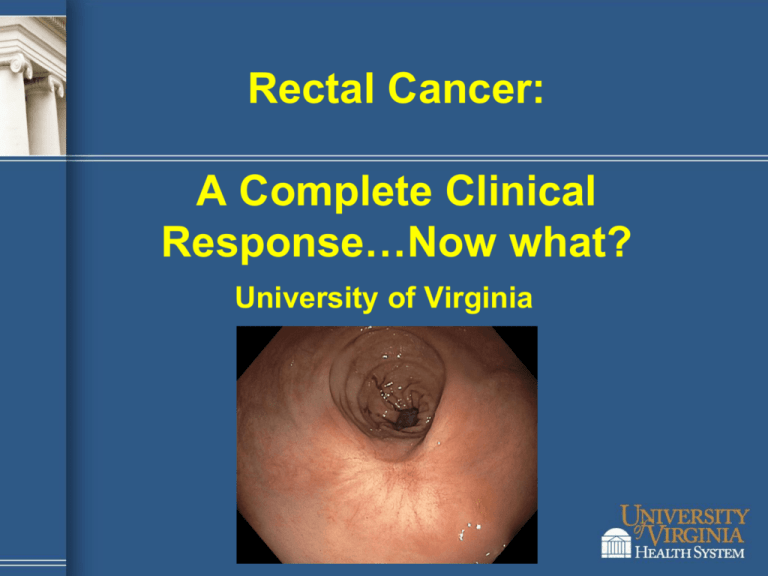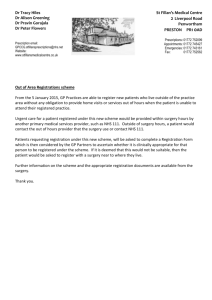
Rectal Cancer:
A Complete Clinical
Response…Now what?
University of Virginia
Objectives
Outline a protocol at UVA for the nonoperative management of patients
with a complete clinical response
following neoadjuvant chemoradiation
for a locally advanced rectal cancer
Standard of Care (NCCN)
Locally Advanced Mid/Low Rectal Cancer
• Neoadjuvant chemoradiation
• Radical surgery with a Total
Mesorectal Excision (TME)
• Adjuvant chemotherapy
Total Mesorectal Excision
after Chemoradiation
Very good oncologic
outcomes!!!
BUT…..
Total Mesorectal Excision
after Chemoradiation
• Mortality, in some series 2%
• Need for stoma
– APR about 30%
– Low anastomosis, temporary or permanent
• Sexual and bladder dysfunction
• Functional problems
– Bowel function
– Depression, body image
• Wound complications
Are we overtreating?
Less Surgery
Pathological complete
response!!! 8-24%
Lancet 2010, Mass M.
5 Year Outcomes
Complete response after radical surgery
Local Recurrence
pCR 2.8%
No pCR 9.7%
Distant metastasis free survival
pCR 88.8%
No pCR 74.9%
Lancet 2010, Mass M.
5 Year Outcomes
Complete response after radical surgery
pCRpCR
2% 90%
No pCR
10%
No pCR 77%
OncoTargets and Therapy 2013, Solanki A
Question
For selected individuals
with a complete clinical
response can we forego
radical surgery??
Annals of Surgery, October 2004
Protocol
•
•
•
•
265 patients, 1991-2002
Tumors <= 7 cm from the anal verge
50.4 Gy
5-FU (425 mg/m2/d) and folinic acid
(20 mg/m2/d) IV for 3 consecutive
days on the first and last 3 days of
radiation therapy.
• NO ADJUVANT CHEMOTHERAPY
Protocol
• Assessed at 8 weeks
• If complete response patients
followed monthly
• If sustained over 12 months
response they were enrolled and
considered complete responders.
• 14 patients “recurred” in first year
(16%)
• 71 enrolled (27% of group)
Incomplete response
Radical Surgery
Local Recurrence
• 2/71 luminal recurrence
– Both treated locally and no recurrence
– No pelvic failures
• 0/22 pelvic recurrence
Systemic Recurrence
• 3/71 (4.2%)
• 3/22 (13.6%)
Mean Follow up
Observation 57.3 months (12-156)
Resected 48 months (12-83)
Survival Data
Observation vs Resected
5
Free Survival
5 yr
yr Disease
Overall Survival
Observation
Observation 92%
100%
Resected
Resected 83%
88%
Concerns
•
•
•
•
Late recurrences with radiotherapy
Single institution
Determining clinical response
Correlation between clinical
response and pathological response
Reaction
• Made surgeons very uneasy
• Not ready for prime time
• Used when patients are elderly, frail
or with metastatic disease
But…..
•
•
•
•
Netherlands experience, 2011
192 patients CRT, 21 CR (11%)
Long course CRT (Oxali, CAP)
17/21 (81%) got adjuvant
chemotherapy
JOURNAL OF CLINICAL ONCOLOGY 2011, Mass, M.
Netherlands
Surveillance Program
Year
CEA
DRE
Endo
MRI
CT for
distant
mets
1
4x
4x
4x
4x
2x
2
4x
2x
2x
2x
1x
3
4x
2x
2x
2x
1x
4
2x
2x
2x
2x
1x
5
2x
2x
2x
2x
1x
JOURNAL OF CLINICAL ONCOLOGY 2011, Mass, M.
Results
Mean Follow up 25 months
• 1/21 developed endoluminal
recurrence
– Refused radical surgery and got a local excision
and now disease free
• 20 disease free
• 2-year DFS is 89% OS is 100%.
• Comparable to control with
ypT0N0M0 after radical surgery
Conclusions
•
•
•
•
Similar overall survival
Better functional outcomes
Salvage surgery possible
Very strict criteria, so some with a
ypT0N0M0 still got surgery
• Adjuvant chemotherapy
Dalton and associates treated 49 patients
with chemoradiation.7 On the basis of MRI
results, 12 of the patients achieved a cCR and
underwent a biopsy 6–8 weekslater, followed
imaging was negative, patients were staged
as initial cCR and placed on the watch and
wait strategy. This strategy included frequent examsand imaging every 2–6 months.
Watch and Wait Strategy
Table 1 | Nonoperative treatment of rectal cancer with the watch and wait approach
Series
Number of
patients treated
Number of
patients observed
Outcome
Habr-Gama et al. (2004)4
265
28
5% luminal recurrence;
93% 5-year survival
Habr-Gama et al. (2013)1
70
47
17% local failure; 72% 3 -year
DFS; 90% 3-year survival
Maas et al. (2011)6
192
21
89% 2-year DFS;
100% 2-year survival
Dalton et al. (2011)7
49
12
50% NED at 26 months
Smith et al. (2012)8
NR
32
21% 2-year local failure;
9% 2-year distant failure
Abbreviations: DFS, disease-free survival; NED, no evidence of disease; NR, data not reported.
NATUREREVIEWS|GASTROENTEROLOGY&HEPATOLOGY
Minsky, 2013
TOLOGY
ADVANCE ONLINE PUBLICATION | 1
© 2013 Macmillan Publishers Limited. All rights reserved
Conclusions
• Highly selective non-operative
therapy may be appropriate
• Salvage surgery possible
Can we increase the number
of complete responders?
• Wait longer
– Double complete response if you wait longer than 8
weeks
• More radiation
• Different chemotherapy regimens
– Oxaliplatinum, Avastin
– Different timing
• Adjuvant chemotherapy
Diseases of the Colon and Rectum, 2013
Inclusion Criteria
• 2006-2010
• Palpable tumors, no more than 7 cm
from anal verge
• cT2-T4, cN0-N1, cM0
• High resolution MRI or 3-D
Endorectal ultrasound
• Chest/Abd/Pelvic CT scan
Treatment
• 54 Gy
– 45 Gy via 3-field approach
– 9-Gy boost to the primary tumor and perirectal
tissue (54 Gy total).
• 3 cycles bolus 5-FU (450 mg/m2), 50
mg of leucovorin for 3 consecutive
days every 3 weeks
• After radiation, patients received 3
additional cycles of chemotherapy
every 3 weeks.
Inclusion criteria
• Assessed at 10 weeks
• Complete response based on
physical exam, endoscopy and
radiology (MRI or PET/CT scan)
No adjuvant chemotherapy
was given
Patient Demographics
Copyright © 2013 Diseases of the Colon & Rectum. Published by Lippincott Williams & Wilkins.
33
Surveillance Strategy
Copyright © 2013 Diseases of the Colon & Rectum. Published by Lippincott Williams & Wilkins.
34
Watch and Wait
Results
Copyright © 2013 Diseases of the Colon & Rectum. Published by Lippincott Williams & Wilkins.
35
Salvage Procedures
Early Regrowth
Copyright © 2013 Diseases of the Colon & Rectum. Published by Lippincott Williams & Wilkins.
36
Salvage Procedures
Early Regrowth
• Early Regrowth 17%
• Salvage procedures seem
successful
• Low local re-recurrence
• Systemic recurrence an issue
• Follow up relatively short
Frequent assessment
critical to success!!!
Salvage Procedures
Late Recurrences
Copyright © 2013 Diseases of the Colon & Rectum. Published by Lippincott Williams & Wilkins.
38
Salvage Procedures
Late Recurrences
•
•
•
•
Late recurrences 10%
Salvage surgery seems successful
Low local recurrence
Systemic recurrence thus far not as
big an issue
• Follow up pretty good
Continuing assessment
critical to success!!!
Conclusions
Extended Chemoradiation with 54 Gy
•
•
•
•
•
Initial complete response 68%!!
17% failure in first 12 month
10% failure long term
Salvage surgery likely
51% handled non-operatively!!
What are we doing
• Last several years offering nonoperative therapy to those that have
a complete response and:
– 1. Have metastatic disease
– 2. Too frail for surgery
– 3. Refuse surgery
What we would like to do
• Develop a UVA protocol for this
patient population
• Inclusion criteria
• Follow up protocol
• Track outcomes
Neoadjuvant XRT
8 Week
Assessment
Complete Response
Significant regression
Poor response
RE-Assess
in 8 weeks
Enroll
Complete
response?
Yes – Enroll
No - Radical
Surgery
Radical Surgery
Enroll
• Encourage adjuvant chemotherapy
– Discretion of referring oncologist
• Follow up
– Flexible Sigmoidoscopy and exam every 3 months
– CEA every 3 months
– Imaging every 6 months – Alternate MRI and PET
CT scan
– For how long??
Imaging options
• Endorectal ultrasound
• PET CT Scan
• Pelvic MRI
– Techniques (Diffusion weighted)
• Combination
Questions and Concerns
• Do we need
minimal standards•
for neoadjuvant
XRT?
• Recommend
“boost” if don’t
•
operate?
• Recommend or
•
require adjuvant
chemotherapy?
Define complete
clinical response
or just surgeon
discretion?
Decide on
imaging follow up
How long do we
follow?
Thank you









